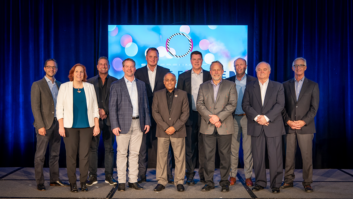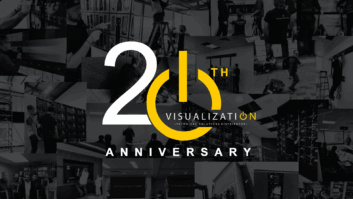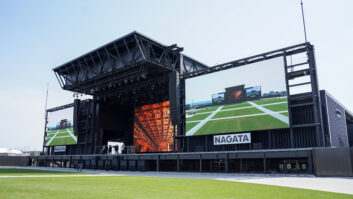The market in which systems integrators (SI) and consultants operate has always been subject to plenty of unexpected bumps in the road. Events of both a global significance (eg 9/11) and more of a localised impact (various national political and economic machinations) have often had an effect on the ebb and flow of new projects, as has the advent of new audio/visual technologies – the latter emerging more frequently than ever during the last 10-15 years.
Even so, it’s arguable that the combination of circumstances to have affected SIs since the onset of the pandemic is early 2020 is without parallel in the last 75 years. And while Installation has frequently checked in with manufacturers and specific influential figures about the impact of recent events – as well as their expectations for the future – it’s come to our attention that SIs have been less well-represented. That is something we intend to address both in general market overviews from now on, and in a cycle of SI-focused articles that will cover a host of hot industry and technology topics.

But it makes sense to begin with an overview of the SI sector as the pandemic recedes and project levels pick up once again. Seven SIs (and/or consultants) from around the world have been interviewed for this feature, and there is no doubt that the overall impression is one of optimism. For at least the last 12 months, activity levels have been very healthy, whilst there has also been an enhanced desire to interact with new technologies – especially those that can improve the workplace or the immersive appeal of visitor attractions.
There is also an acute awareness that the cycle of customers’ needs is going to spin more swiftly from now on. As a result, SIs will need to be both flexible and responsive if they are to stay relevant. But once again, the attitude seems be one of enthusiastically embracing the challenge, perhaps aware that it’s always been this kind of renewal that keeps the business viable and ensures that it’s an exciting place to work.
PANDEMIC IMPACT
The starting point for the SI interviews was to ascertain what kind of short-to-term impact the pandemic had had on their activity levels in 2020 – and at what point those had begun to recover.
Based in London, inurface media specialises in projects based around digital signage and interactive technology. Founder and CEO Josh Bunce comments: “The short-term impact was a 3-month drop in existing business delivery, primarily due to a combination of our retail customers’ stores being closed and their furlough situation, along with our operations team designing and implementing Covid-safe working measures, which took time. Medium-term our main challenge has been component shortages; however, due to our historically strong commitment to internal stock levels, this hasn’t affected us negatively for our run rate items.”
Mark Childerhouse is director of Pioneer Group, which provides AV solutions, electrical contracting and networking infrastructure across numerous sectors, including venues and retail. And it was those two markets where things first began to pick up. “The start of the pandemic was difficult and we saw losses,” he says. “But from around September 2020 things took a turn for the better, and as a business we grew 50% on the previous year. [Clients such as venues, restaurants and retailers] took the opportunity while their facilities were empty to make upgrades. [Also] many outlets that didn’t previously offer takeaways or drive-thru suddenly had to switch to curb-side collections, and so many installed signage and kiosks to allow for this.”
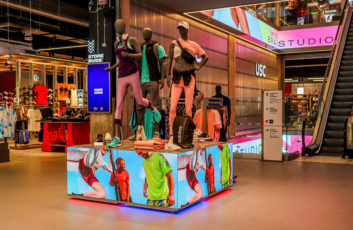 Brian Cole is president & CEO of Edgefactory, a US-based creative production services active in digital signage, live events and more. “In 2019, probably 2/3rds of our business was live events, so when the pandemic hit there was an element of having to reinvent the wheel,” he recalls, adding that the company successfully shifted its focus to producing and delivery virtual events. But in the last 12 months, in particular, the desire for in-person productions has “returned strongly, and there’s also a real interest [among clients] in expanding the use of AV.”
Brian Cole is president & CEO of Edgefactory, a US-based creative production services active in digital signage, live events and more. “In 2019, probably 2/3rds of our business was live events, so when the pandemic hit there was an element of having to reinvent the wheel,” he recalls, adding that the company successfully shifted its focus to producing and delivery virtual events. But in the last 12 months, in particular, the desire for in-person productions has “returned strongly, and there’s also a real interest [among clients] in expanding the use of AV.”
PROJECT DELAYS
Jason Yeung, technical sales engineer at Cosmovision, a Hong Kong-based AV systems design and integration company: “Project delays were definitely one of the most critical impacts we experienced. Products were often delivered on-site, while our system integration team wasn’t able to resume on-site installation and integration works due to Covid restrictions for construction sites.”
The biggest wave of the pandemic hit Hong Kong later than in many other territories, so it’s only comparatively recently that operations have resumed a more recognisable rhythm. “In Hong Kong, we saw these restrictions ease in Q2/Q3 of 2022, when we were able to continue our scheduled works.”
Pratik Wadhwa is director of Modern Stage Services, and is based in Delhi, India – a country where Covid rates were especially high during periods of 2020 and ’21. “India did have a very bad situation with Covid last year, and whilst there was some improvement [during 2021] it was not that much. However, this year things have been slowly getting back to normal in India,” he says, adding the business is now evenly balanced between installations and events, whereas before the pandemic it had been “about 80/20 in favour of events.”
Providing an especially distinctive take on events of the past few years is Faye Bennett, founder and MD of Faye Bennett Consultancy Services, which works with integrators, distributors, manufacturers and end-users to develop their service offerings and strategies. “It’s been really interesting because we didn’t see a downturn in our business at all,” she says. “One of our observations was that a lot of companies in the channel had been on a treadmill of project after project, and had not really had the opportunity to look at services as a revenue stream. When the pandemic happened and a lot of projects were shut down, it did provide some bandwidth in which people could think about their service strategy [and then take action] so they were in a position of being ready to go when the world opened up again.”
ROARING BACK
The impression of a sector roaring back to life has been present in many areas, especially those involving performance-driven creative arts. No shortage of such signs in SI, either, with all contributors reporting an increased willingness to invest in new technologies – a result, no doubt, of unexpected down-time that afforded them a chance to research solutions and contemplate the future.
 The impact of greatly increased WFH and hybrid working has already been covered extensively in Installation, but to briefly reiterate it has undoubtedly contributed to an ongoing cycle of projects for SIs. This is confirmed by Mark Weston, who is owner and managing director of CI.Connect, a company specialising in the design, delivery and installation of video conferencing solutions.
The impact of greatly increased WFH and hybrid working has already been covered extensively in Installation, but to briefly reiterate it has undoubtedly contributed to an ongoing cycle of projects for SIs. This is confirmed by Mark Weston, who is owner and managing director of CI.Connect, a company specialising in the design, delivery and installation of video conferencing solutions.
Inevitably, the pandemic brought interest from clients working with health authorities who “needed our expertise in the meeting rooms and desktop spaces so they could still function during the crisis.” Elsewhere there was an impact from “projects being postponed, [and especially] from a corporate side where they might not know when they were going to happen.”
Once things had begun to settle down again, the new hybrid working era brought some widely shared requirements from corporate customers. “People had got used to using Teams and Zoom from home, and wanted to bring that back into the [office-oriented] meeting experience. They liked a simplified GUI experience and didn’t want to go into a conference or meeting room with a totally different set-up. So systems had to change to match that,” says Weston.
Longer-term, there has been another consequence of increased remote working. “Projects might change, and instead of four floors of a new building it might only involve two now, since hybrid has been a success and [companies] don’t require as much desk-space as originally needed. But this hasn’t been a loss from an AV perspective – in fact, it’s actually led to more business as people have wanted to change what they had into Teams-enabled meeting rooms. Investment in video-conferencing and meeting rooms has increased [from what it was pre-pandemic].”
IMMERSIVE DEMAND
Elsewhere, the rise in demand for immersiveness – not least as a way to lure consumers back after several years spent mainly at home – is a recurring theme. “A lot of our clients, existing and new, are looking for ways they can adapt immersive technology into their stores and spaces,” says Bunce, who alludes to work on a number of flagship retail stores such as Sports Direct Birmingham New Street. “We have helped our clients find ways to integrate interactive, touch and touch-free, experiential technology that helps elevate them above their competitors. Additionally, the same clients have shown a strong demand for UC solutions, primarily within their office spaces including boardrooms, meeting rooms and huddle spaces. […In UC] the key requirement has been on premium experiences for staff, so we have seen greater desire for the higher-end approach with dedicated ceiling microphones and ceiling speakers going into even smaller rooms which may traditionally use all-in-one bar-style devices.”

Retail and corporate have also been to the fore for Pioneer Group in terms of harnessing new technologies and ways of working. “We have seen an uplift in requests from corporate clients looking to ‘homeify’ their offices,” says Childerhouse. “With so many people having experienced home working, companies are looking at how to bring those comforts in to the office and make the office a destination that people want to spend time in. I believe they are turning to companies like Pioneer Group because they are seeing the work we do with trending companies like Joe & the Juice and Gymshark, and can see that we understand how to use technology to give them this ‘destination experience’.”
Demand for larger AV products is also back. “We are also seeing a lot of our retail and QSR [Quick Service Restaurant] clients utilising AV technology to a higher level in their own corporate offices,” says Childerhouse. “For example, we have recently installed some large LED screens and interactive touch panels into [UK HQ of bicycle company] Giant – providing them with an immersive reception area, presentation space and interactive showroom area to invite their partners and retailers to showcase products.”
Meanwhile, Wadhwa cites museums, live events and exterior installations as among those applications requiring more immersive experiences. “There will be more interactivity, [and across the board] there is a trend for getting people to be more engaged in things,” he says, pointing to multiple projects involving outdoor projection mapping.
DEMAND UPTICK
For Yeung, the last year also been dominated by an uptick in demand for immersive visitor attractions. “We were able to realise some really nice projects during 2022, such as The Big Eight – Dinosaur Revelation, the Peak Tram revamp and the Mai Po Education Centre,” he says. “As the side effects of the pandemic are [now] subdued, the demand for museum, attraction spaces and attractions has grown as people are eager to visit and experience difference immersive spaces.”
Meanwhile, Yeung is not alone in citing a drop in demand for virtual events after a period in which there was often no alternative: “Many clients would [prefer to] defer their plans for projects rather than go in the direction of ‘virtual’.”
At the time of writing, from a UK-based perspective, it’s difficult to imagine a more unpredictable period. A potentially huge and lasting recession is underway, while strike action is being taken in many areas of the public sector. With international political instability also continuing, it’s hard to feel too optimistic about 2023. But whilst there is an acknowledgement of this uncertainty, SIs are tending to focus on the possibilities of technology renewal.
“[There is] talk about how businesses are going to be looking hard at increasing margins, and there are obstacles such as fuel and food costs – but technology does have the ability to provide savings,” says Childerhouse. “For instance, kiosks alone can increase the typical order value by between 12 and 22%, and reduce waste through better reporting.”
RECESSION COMING
“The recession is coming and there has been some discussions [in the industry] about end-user blocks who won’t have the CapEx for the next [cycle of investment],” says Bennett, adding that where spending is able to take place it behoves all industry stakeholders to “have the right products and services [available], which means that the communication between integrations and end-users is really key. So it’s a time for integrators to be planning and talking to customers about what is happening and what can be done, and [responding] in light of that feedback.”
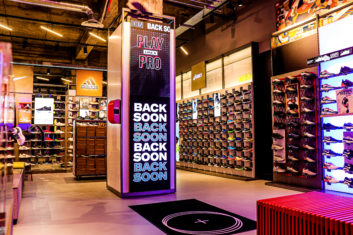 Bunce arguably strikes the most upbeat tone of all. “We are optimistic for the coming year and are investing heavily in our team, specifically for training, support and maintenance,” he says. “We always closely monitor our anticipated workload and are looking at a positive Q1 and Q2 for 2023. The brands we are currently working with, despite the economic situation, are looking to the future, and want to ensure they work with reliable suppliers and integrators that help them build spaces that will keep them towering over their competitors.”
Bunce arguably strikes the most upbeat tone of all. “We are optimistic for the coming year and are investing heavily in our team, specifically for training, support and maintenance,” he says. “We always closely monitor our anticipated workload and are looking at a positive Q1 and Q2 for 2023. The brands we are currently working with, despite the economic situation, are looking to the future, and want to ensure they work with reliable suppliers and integrators that help them build spaces that will keep them towering over their competitors.”
It will undoubtedly be fascinating to see what transpires as 2023 gets underway. But even if it’s been a “rocky road” (to quote Bennett) for AV as a whole in recent years, there is still plenty of excitement about new technologies and their transformative potential. “It has been a case of going from one wave to the next, and it’s still not clear what the future of AV will look like,” she says. “So it’s hard to predict, but there is opportunity there if you can understand what customers do have, where value can be added, and how the [time ahead] can be used to safeguard your business.”
So, in short, an SI sector that can be both proactive and responsive stands an excellent chance of prosperity, even in these perilous times.
